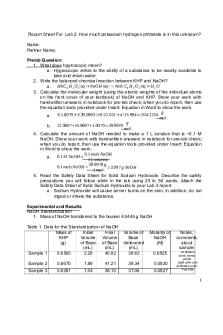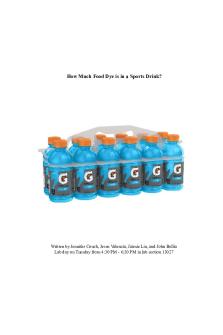Lab 2: How much Potassium Hydrogen Phthalate is in Unknown? PDF

| Title | Lab 2: How much Potassium Hydrogen Phthalate is in Unknown? |
|---|---|
| Author | Jaeda Smith |
| Course | Quantitative Analytical Chemistry Laboratory |
| Institution | Kennesaw State University |
| Pages | 6 |
| File Size | 192.7 KB |
| File Type | |
| Total Downloads | 40 |
| Total Views | 133 |
Summary
Lab 2: How much Potassium Hydrogen Phthalate is in Unknown?
Finding number of moles in unknown using dilution formula and stoichiometry....
Description
Report Sheet For Lab 2: How much potassium hydrogen phthalate is in this unknown?
Name: ______________________________ Partner Name: _____________________________ All must be typed in black ink. Increase the space between questions to insert your answers. The grading rubric is provided separately. Prelab Question: 1. What does hygroscopic mean? Readily taking up and retaining moisture. Reference: https://www.merriam-webster.com/dictionary/hygroscopic 2. Write the balanced chemical reaction between KHP and NaOH? HKC8H4O4(aq) + NaOH(aq) → NaKC8H4O4(aq) +H2O(l) 3. Calculate the molecular weight (using the atomic weights of the individual atoms on the front cover of your textbook) of NaOH and KHP. Show your work with handwritten answers in notebook for pre-lab check; when you do report, then use the equation tools provided under Insert: Equation in Word to show the work. KHP (HKC8H4O4): H: 1.0079 × 5 = 5.0395 K: 39.0983 × 1 = 39.0983 C: 12.0110 ×8 = 96.0880 O: 15.9994 × 4 = 63.9976 KHP Molecular Weight = 204.2234g/mol NaOH: Na: 22.9897 ×1 = 22.9897 O: 15.9897 ×1 = 15.9897 H: 1.0079 × 1 = 1.0079 NaOH Molecular Weight = 39.9970g/mol 4. Calculate the amount of NaOH needed to make a 1 L solution that is ~0.1 M NaOH. Show your work with handwritten answers in notebook for pre-lab check; when you do report, then use the equation tools provided under Insert: Equation in Word to show the work.
1
.01M NaOH =
xmoles NaOH 1L solution
0.1moles NaOH ×
39.9970g/mol 1molnaOH
= 3.9970g NaOH
5. Read the Safety Data Sheet for Solid Sodium Hydroxide. Describe the safety precautions you will follow while in the lab using 25 to 50 words. Attach the Safety Data Sheet of Solid Sodium Hydroxide to your Lab 3 report. When handling the solid sodium hydroxide NaOH(s) you must be very careful not to let the chemical touch your skin directly because its is an irritant that can cause second- or third-degree burns. Do not ingest or inhale this chemical as you will need to seek medical advice immediately. Avoid contact with your eyes and do not wear contact lenses, as it will complicate the safety procedure if you are to get into contact with the chemical. Reference: https://pubchem.ncbi.nlm.nih.gov/compound/Sodium-hydroxide
Experimental and Results NaOH Standardization 1. Mass of NaOH transferred to the beaker _____4.1843g___ (don’t forget units) Table 1: Data for the Standardization of NaOH Mass of Initial Final Volume of KHP Volume Volume of Base of Base Base delivered (g) (mL) (mL) (mL) Sample 1
0.6226g
0.50mL 33.70mL 33.20mL
Molarity of NaOH (M)
0.918M
Notes, comments about sample When titration hit, the color was a medium pink/ fuchsia Slight increase in temperature of flask.
Sample 2
0.6165g
0.35mL 29.95mL 29.60mL
0.1019M
When titration hit, we achieved a faint pink color. Slight increase in
2
temperature of flask.
Sample 3
0.62615g 0.50mL 29.85mL 29.85mL
0.1020M
When titration hit, we got a light pink that was inbetween the first and second titration colors. Slight increase in temperature of flask.
2. Provide one sample calculation of the molarity of NaOH (use equation tools under Insert: Equation in Word): KHP and NaOH have a 1:1 ration in balanced equation therefore, there are 0.00304 moles of NaOH in 33.20mL which makes the molarity of NaOH equal to: 0.66226g 204.2234g/mol
= 0.00304 moles KHP
0.00304moles 0.0332L
= 0.918M NaOH
3. Use your calculator or Excel to find the average molarity of the NaOH solution and give the answer here: Average molarity of the NaOH solution: 0.09855M 4. Use your calculator or Excel to find the standard deviation of the molarity of the NaOH solution and give the answer here: Standard deviation of molarity of NaOH solution: 0.005845725 5. Using the correct number of significant figures, report the molarity and standard deviation of the NaOH solution and give the answer here. Molarity: 0.0986M Standard Deviation: 0.0058 Solution of NaOH is 0.0986M ± 0.0058
3
Unknown Analysis: Use the average molarity of your NaOH for the calculations of your unknown. Table 2: Data for the Determination of %w/w of KHP in an Unknown Sample Unknown Mass of Initial Final Volume of % w/w of Notes, Number unknown Volume Volume of Base KHP in comments of Base Base delivered unknown about ___MW___ (g) (mL) (mL) (mL) sample Sample 1
0.5019g
0.55mL 11.10mL 10.55mL
42.30%
Faint pink color change. Reaction occurred more rapidly than in known solution trial.
Sample 2
0.5133g
0.48mL 11.25mL 10.77mL
42.23%
Faint pink color change. Reaction occurred more rapidly than in known solution trial.
Sample 3
0.5072g
0.51mL 11.19mL 10.68mL
42.38%
Medium pink color change. Reaction occurred more rapidly than in known solution trial.
6. Provide one sample calculation of the % w/w of KHP in the unknown (use equation tools under Insert: Equation in Word): Equal moles of KHP and NaOH in the solution at equivalence point. 0.0986M NaOH × 0.01055L = 0.0010397 moles NaOH 0.0010397 moles KHP ×
204.2234g/mol = 1moleKHP
0.2123g KHP
Percentage of KHP in unknown solution: 0.2123g KHP × 100 = 42.30% 0.5019g unknown 7. Use your calculator or Excel to find the average %w/w of the KHP in the unknown and give the answer here: Average weight percentage: 42.30% 4
8. Use your calculator or Excel to find the standard deviation of the %w/w of the KHP in the unknown and give the answer here: Standard Deviation of %w/w: 0.08% 9. Using the correct number of significant figures, report the %w/w and standard deviation of KHP in the unknown and give the answer here: Percent weight of KHP in unknown is 42.30 ± 0.08 Percent weight KHP: 42.30 Standard Deviation: 0.08 Post Lab Questions 1. Why was the NaOH not dissolved in a Volumetric Flask? We didn’t need to use a volumetric flask to dissolve the NaOH because we only needed an approximate number, and not an exact number. Since we calculated the molarity after we didn’t need an exact volume of 1 liter. 2. What happened to the flask when you dissolved the NaOH in the beaker? The temperature of the flask increased to a little bit above room temperature. This was caused by an exothermic reaction taking place in the beaker. 3. What type of reaction occurs between NaOH and phenolphthalein? A strong base- weak acid reaction occurs between the two. 4. Why do you only add two drops of phenolphthalein? Two drops of the indicator will be the correct amount because it will provide the most accurate color change during titration. Any additional indicator added would cause the pH in the solution to change. 5. Were any samples not included in the calculation for molarity and if yes, why? The NaOH solution was not included to calculate the molarity. The sodium hydroxide was a hygroscopic substance so the mass fluctuates as the moisture in the air absorbs it, therefore making it an unreliable factor when calculating molarity. 6. Were any samples not included in the calculation for %w/w and if yes, why? All of the samples were included in the calculation for %w/w. The average molarity of NaOH was 0.09855M which was used to calculate the weight percentage. The volume of base delivered of the unknown was also used in order to find the weight percentage. From that number we multiplied it by the molecular weight of KHP (204.22g/mol). We then used this number and divided it by the mass of the unknown for each of the three trials to find the %w/w then found the average and standard deviation of the weight percentage using a calculator.
5
7. Explain the chemistry occurring during the titration and at the endpoint. This should be in paragraph form and contain 50 – 70 words. A titration according to Merriam- Webster is ‘a method or process of determining the concentration of a dissolved substance in terms of the smallest amount of reagent of known concentration required to bring about a given effect in reaction with a known volume of the test solution’. During the titration we funneled the base out of the buret into the beaker of solution that we created, which included an indicator. With the indicator in the solution, it makes it possible to see the exact point when the moles of hydrogen ions from the acid equal moles of the hydroxide ions from the base shown by a color change depending on the indicator used. This means that the stoichiometric ratio is equivalent, and the equivalence point is shown by the end point of color change. Reference: https://www.merriam-webster.com/dictionary/titration Write a concluding statement indicating the %w/w of KHP in the unknown: When taking the weight percentage of the KHP in the unknown given to us in lab (MW) we found that the average weight percentage of KHP found in our unknown was 42.30%. We used the numbers and data recorded during the experiment to find the weight percentage. From there found the average and standard deviation.
6...
Similar Free PDFs

Bwssb COMM2 - How much
- 1 Pages

Ejercicios con how much , many
- 2 Pages

How much do you remember
- 1 Pages

Unknown Bacteria Lab Report
- 5 Pages

(Sample) Unknown Lab Report
- 6 Pages
Popular Institutions
- Tinajero National High School - Annex
- Politeknik Caltex Riau
- Yokohama City University
- SGT University
- University of Al-Qadisiyah
- Divine Word College of Vigan
- Techniek College Rotterdam
- Universidade de Santiago
- Universiti Teknologi MARA Cawangan Johor Kampus Pasir Gudang
- Poltekkes Kemenkes Yogyakarta
- Baguio City National High School
- Colegio san marcos
- preparatoria uno
- Centro de Bachillerato Tecnológico Industrial y de Servicios No. 107
- Dalian Maritime University
- Quang Trung Secondary School
- Colegio Tecnológico en Informática
- Corporación Regional de Educación Superior
- Grupo CEDVA
- Dar Al Uloom University
- Centro de Estudios Preuniversitarios de la Universidad Nacional de Ingeniería
- 上智大学
- Aakash International School, Nuna Majara
- San Felipe Neri Catholic School
- Kang Chiao International School - New Taipei City
- Misamis Occidental National High School
- Institución Educativa Escuela Normal Juan Ladrilleros
- Kolehiyo ng Pantukan
- Batanes State College
- Instituto Continental
- Sekolah Menengah Kejuruan Kesehatan Kaltara (Tarakan)
- Colegio de La Inmaculada Concepcion - Cebu










